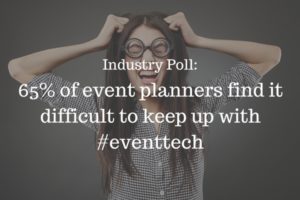From chatbots, Artificial Intelligence and mobile apps to live-streaming, 360 cameras and special lighting effects – this year’s Wimbledon tennis championships is putting innovation at a whole new level when it comes to event tech. According to an article in this week’s Evening Standard newspaper, apps and smart technology are helping the tennis tournament’s players ace their game through things like connected rackets and smart trainers. But what’s really standing out this year, is the way organisers are using technology to engage with existing supporters and expand the tournament’s global audience.
Have a look at how the Wimbledon tennis tournament is using technology to drive innovation and engagement:
Event App – The Wimbledon championships mobile app is designed for those attending the tournament, as well as those on the move – while those at home or in the office can tune in by visiting the www.wimbledon.com website and listening to the commentary on the HearO Bluetooth speaker (which, by the way, is housed inside a tennis ball!). The use of the app within the grounds, however, is more subtle. As Alex Willis, head of communications at the All England Lawn Tennis and Croquet Club explains: “The aim is to enhance spectator’s experience but to very much keep the innovations hidden.”
Three public WiFi hotspots have been installed across the grounds this year, ensuring the venue has adequate bandwidth to support connectivity on visitors’ smartphones. Users can use the app to launch the IBM SlamTracker – the tournament’s scoring application which provides real-time scores, stats and point-by-point analysis of each match. Filters make personalisation possible by allowing visitors to receive information solely on the men’s singles, for example, or on players from a particular country. Whereas, the app’s ‘competitive margin’ predicts how two players will perform against each other. The system even analyses how well each player tends to do in specific situations (when serving for a set, for example) to gives fans a richer experience.
Read: 10 Reasons Why Your Attendees did NOT Use Your Event App
Live Streaming – Live streaming has been one of the most interesting technology trends in our industry this year and its impact is set to grow, based on the investment we’re seeing pouring in – both from vendors and event planners. It is a powerful marketing tool that allows you to instantly reach out to your audiences, as well as build and engage with new ones too. Attendees seem to be up for the game too. Many of them now are using their phones to share their experiences and stream events live on their social media networks through apps like Periscope, Facebook Live, Instagram Stories and Snapchat Live Stories.
Twitter this year has partnered with Wimbledon to live stream all the coverage on the Wimbledon Channel to users on the social media network. Tennis fans from around the world are able to watch a range of daily content, including news, interviews, behind the scenes footage and selected action. The Wimbledon Twitter channel also includes a real-time curated timeline of tweets involving live conversations surrounding the grand slam.
Read: 7 Mistakes to Avoid When Using Facebook Live at Events
Artificial Intelligence – We’ve already seen how AI is starting to play a big part in events – with automated check-ins and scheduling, attendee matching and advanced attendee reporting. This year, tournament organisers are using AI technology to supply video highlights just minutes after a match has finished. Journalists would have previously have had to sift through hundreds of hours of footage for a highlight reel – a daunting task when you’re looking at three matches per court per day. The new technology picks out key moments based on an analysis of statistics, social media reaction and player reaction – even down to when they fist-pump! It dramatically increases the speed at which highlights packages can be put together, and provide followers of the tournament with detailed video content minutes after a match has ended.
Chatbots – Mobile apps that help attendees navigate, network, set appointments, and do all of the things that event apps do are practically growing on trees. But there is a sector of the live-event space that remains underserved by mobile apps and that’s where chatbots come in. Chatbots are software programmes that include AI components and allow users to conduct conversations via audio or text – so rather than download, learn, and search for information on a mobile app, attendees can have conversations with event organisers using platforms like the event website, Facebook Messenger or more commonly, the text-messaging feature on their smartphones.
This year, Wimbledon is using ‘Fred’ – a chatbot named after Britain’s three-time Wimbledon champion, Fred Perry. It is enabled by IBM’s Watson technology and helps answer questions from fans visiting the event – from where to buy drinks, or the nearest place to buy a Wimbledon towel to how to get home. It is a great example of how technology can help event planners deliver easy, instant and personalised communication with attendees.
Wearable Technology – It seems as tennis has got smarter over the years, so too have the rackets. The latest models used by players in the tournament are connected to the Internet using a sensor embedded in the handle. Much like other wearable devices aimed at the health and fitness market, the technology synchs with a matching app via Bluetooth, recording every minute detail of the player’s performance. It also has a connected tennis wristband that links with phones. A bit like a coach who never drops the ball, the data can be streamed to players’ smartphones so they can analyse every aspect of their game.
There are a number of solutions in our industry that are using wearable technology to provide users with insight on their behaviour. For example, SmartTrac by hubevents combines a small two-way beacon for each attendee (attached to the badge lanyard) and proximity sensors in exhibitor booths or meeting rooms to replay relevant insight, reporting and notifications to event audiences. Visitors get access to complete journey reports, including a timeline view of booths they’ve visited, people they’ve met at the event – as well as the time, duration and location of those meetings.
Lighting & Filming Technology – The importance of lighting at any event is often underestimated – not only does it give depth and ambiance to a space but can have a profound effect on the overall event experience. This year, Wimbledon is using a new state-of-the-art lighting system which aims to improve TV broadcasts of the tournament by offering light controls that combat sunlight glare. Organisers are also using 360-degree cameras to provide greater exposure for the practice courts – an area previously off-limits to cameras. For those who can’t make it to the grounds, they have the option of watching their favourite players on the practice courts live on the mobile app. Recognition software will pick out who each player is to help supporters identify the players they most want to watch.
Would you like to read similar articles on how technology can help drive engagement at events? Sign up to the weekly EventTech Talk newsletter to get all the latest event tech news and trends that are shaping the events and meetings industry today.
Sources:
Evening Standard: How apps and smart tech are helping tennis players to ace Wimbledon
The Telegraph: How Wimbledon is using Artificial Intelligence to enrich the fan experience











